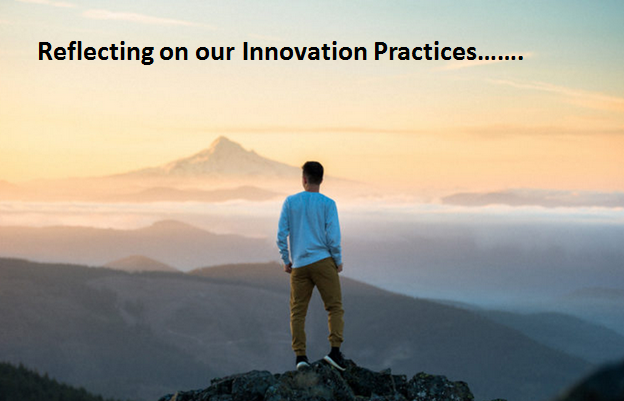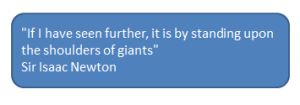 Innovation has been rapidly changing and much of its basics have been swallowed up by some newly defining frameworks that have raced up to the top of the innovation agenda. They have driven much of our thinking and reacting. It is right that we all respond to these but we often forget much of the rest of what innovation needs to be built upon.
Innovation has been rapidly changing and much of its basics have been swallowed up by some newly defining frameworks that have raced up to the top of the innovation agenda. They have driven much of our thinking and reacting. It is right that we all respond to these but we often forget much of the rest of what innovation needs to be built upon.
The problem or challenge with this focusing upon ‘breaking’ practices or new methodologies, are they can be so much harder to master and build them into established positions and practices, without the right amount of debate, understanding and assessing the implications and impact.
This often needs different perspectives to form the final position. We fail to constantly review and re-engineer the innovation process and tend to layer more upon it, without a consistent reassessing what we are trying to achieve.
The excitement of ‘breaking innovation’ is in the pioneering, experimenting, discovering, sharing and exchanging. If you are always open to this new thinking, it does enrich and advance innovation understanding and that makes it so valuable but so demanding.
Many of these for me have been utterly enjoyable to explore as they advance our understanding of the emerging management practice of innovation but you can’t ‘gloss over’ the basics of innovation.
The ability to translate innovation understanding is a constant challenge. The ‘lead- lag’ time is sometimes very long and tortuous to make the necessary changes within established organizations to achieve the necessary ‘buy-in’ and understanding of the impact and return and establish a certain rhythm and return.
 Doesn’t the innovation needle keep shifting constantly?
Doesn’t the innovation needle keep shifting constantly?
Often we were missing the constants that are required to ‘set in place’ for innovation, I call these those anchor points, otherwise, we often are simply increasing the layering on, more and more, not giving enough emphasis on how to integrate these into a newly emerging practice of innovation that builds on a solid foundation.
The basics of innovation still form around building the engagement, leadership, and involvement, in constructing a culture, the climate and environment needed, so as to allow innovation to evolve and thrive. Then there is that need for a constant investment in people, in our networks and relationships, that all need to come together. These are the foundation to build innovation capacities.
Then, we have the investments in structures, systems, and governance, making sure these are flexible and robust enough to make what we work upon, as responsive, agile, adaptive, exploitative and exploratory. All coming together so we can end up with great new ideas, things and most importantly, in winning successful concepts that grow our business.
The shifts taking place around innovation have been significant in their impact
The shifts taking place has been hugely shaped in how digital transformation continues to grow in its importance. how it is influencing much that is surrounding innovation, as it continues to disrupt in faster, demanding ways, where it deconstructs and then, it is forcing us to reconstruct our innovation thinking, so as to gain from all this transformation occurring all around us.
The other real forces of innovation change in this relatively short period have come from a great explosion of Lean Management principles and practices and the incorporating of Design thinking into our work. Both of these are being rapidly embraced by our organizations, large and small. How these are fully and successfully integrated remains a challenge for most to resolve today.
The understanding of relating more to individual customer needs, building new business models has been greatly encouraged by the real need to “get out of the building” and learn to pilot, experiment and build a growing system of prototyping on what we learn from these engagements and testing, many emerging from innovation labs, encouraging an intrapreneur spirit, set up on entrepreneurship principles.
Then you have the emergence of platform and ecosystems to build around that are about to massively change the way we collaborate and build solutions that are more complex and require many parties to come together and attempt to solve greater challenges. The movement towards the different crowdsourcing techniques and all the variations (or derivation’s) of ‘crowd’ and co-creation’ have changed the game.
Innovation is constantly opening up when you combined diverse thinking with all the ramifications of the network and relationship building effect we need to leverage. It is this ‘raw’ power of technology that is transforming much.
The raw power of knowledge needs harnessing and translating
It is this ‘raw’ power of technology, pushing the flow of knowledge and exploiting the different social mediums that are swirling around us, with many suggested designs and frameworks that need deeper capture and translation, so as to extract new value.
We all need to think through the value of the pivot, prototype, the constructing of minimal viable products and rapid experiment and design to increase in focus, so as to accelerate innovation discovery and delivery.
We are learning faster, shutting down what does not work as we go, adapting faster than before with our innovation concepts, by being engaged and constantly informed by customer needs.
It has moved well into the “how” from the “what, why and where”. The “when” still is subjected to different levels of impatience it certainly still seems. Speed is dominating at present then we all are in need to “Scale” and resolve the constant worries over the “Execution” of the new value proposition.
There is this constant, pressing need, to absorb, synthesize and translate what is constantly coming towards us in innovation thinking. It becomes a constant task to manage just this new understanding, translating it and embedding new practices as difficult, time consuming and tough.
Reflecting on all of this – so what does this all mean?
There is this need to be reacting to this in new framing ways, building this into a new innovation road map for our businesses.
It can be a dangerous assumption that we ‘think’ innovation is well understood; often it is not, it continues to be a serious source of frustration and disappointment, at all levels. This essential ‘fixing the basics’ still needs a clear focus to resolve, coupled with new emerging practices to forge a pathway for others to understand and feel comfortable to use. It needs a constant balance between extolling the old, exploring the new; that blending of practice, existing, new and breaking.
Our need is to ask is how can we blend this emerging thinking into core aspects of the innovating beliefs and structures in place, so they can build and contribute to the ongoing building of innovation capabilities, competencies and capacity, surely a key focal area?
My work entails being reactive, reflective and responsive.
Sometimes as we take stock it does surprise you on how the innovation needle had been moved, again and again. This sometimes makes navigation sometimes difficult
It is clear innovation is constantly advancing, yet, offering my reflective thought here, it can have countless layers of fresh paint but if the basic foundation is not solid, it only hides the truth underneath, that much is simply “rusting away¨. Innovation needs a clear, strong core that needs constantly re-calibrating to the changing market conditions we are finding ourselves in.
We so often miss this fundamental addressing of the urgent need for peeling away these old decaying, rather rusty layers and fixing the basics on a new design, reflecting where innovation is today (not in the past) and where we believe it is heading for in the future by balancing out the portfolio and equipping ourselves with the capabilities and capacities to build these in progressive ways.
May I ask?
Have you ever had an independent assessment of your innovation process simply because the basics around innovation are not common knowledge? I would argue that so often senior teams are somewhat paralyzed in terms of being able to move forward strategically, despite the need and recognition of innovation’s importance
The challenge is how to unlock this often conflicting set of innovation pressures and bring everyone to a common point of understanding of today and where all need to head in the future.
I certainly believe we are in need to conduct some vigorous analysis of the innovation system as we have understood a lot but much does need to be challenged as the future will be managing innovation in a very different way; more collaborative, more open, more reliant on technology and customer involvement
I’d certainly recommend starting with both an Innovation Work Mat discussion and a Three Horizon framing of the future from today’s understanding of where we think it is heading and how can we plan out how to get there, in sensible steps, as part of any comprehensive review.
We do need to not only embed innovation practices we need to strive to update these- can I be of help?